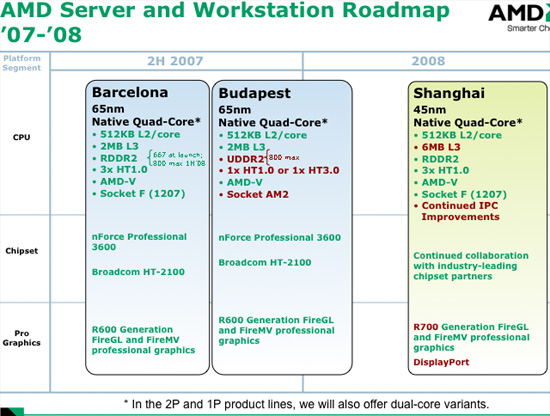AMD reveals next-gen 45nm quad-core processor
Fleshes out short-range CPU roadmap, details DDR3 support

AMD has released details of its second generation quad-core server and workstation CPU, codenamed Shanghai. Meanwhile, we're still waiting for AMD to release its long-awaited debut quad-core CPU, known as Barcelona .
Due out in the second half of 2008, AMD is keeping its cards close to its chest regarding Shanghai's tech specs. Several key specifications including operating frequencies and power consumption figures have not been released.
What we do know is that Shanghai will be largely an evolutionary step up from the Barcelona
design. The most significant enhancement is a die shrink from 65nm to 45nm. On paper, that should allow Shanghai chips to both clock higher and use less power than Barcelona.
The finer 45nm manufacturing process has also enabled AMD to squeeze a little more cache memory into the chip. Shanghai's L3 shared cache memory pool has been tripled to 6MB.
Other than that, AMD claims the chip benefits from a number of unspecified enhancements which deliver improved clock-for-clock performance.
Bulldozer CPU
Like the upcoming Barcelona quad-core chip, therefore, Shanghai is essentially a development of the original Athlon 64 core of 2003 rather than a fundamentally new CPU core design. For that we have to wait until 2009 for the Bulldozer CPU.
Initial Shanghai models will be compatible with existing Socket F motherboards and therefore will support DDR2 memory. Later versions will be the first AMD processor to add support for DDR3 for which a new CPU socket will be required.
Get daily insight, inspiration and deals in your inbox
Sign up for breaking news, reviews, opinion, top tech deals, and more.
AMD did not discuss plans to release a 45nm variant of its upcoming Phenom desktop CPU. However, it's a safe bet that AMD will release 45nm quad-core chips shortly after the Shanghai server chip appears and probably before the end of 2008.
AMD's first quad-core server CPU, Barcelona, is due to launch later this August.
Tech.co.uk was the former name of TechRadar.com. Its staff were at the forefront of the digital publishing revolution, and spearheaded the move to bring consumer technology journalism to its natural home – online. Many of the current TechRadar staff started life a Tech.co.uk staff writer, covering everything from the emerging smartphone market to the evolving market of personal computers. Think of it as the building blocks of the TechRadar you love today.